Commercial Bullet Swaging Equipment
What Tools Do You Need?
The first thing to do is determine the limits for the bullets you plan to make. What is the largest caliber, the longest bullet length, the hardest core material, and the thickest jacket material you plan to use?
These things help determine the size of press and dies required. There may be some exceptions depending on exact shape desired (more pointed bullets require more pressure to form and thus can reduce other limits), but generally, here are the quick guide-lines and limits:
- Reloading press
- Soft lead cores only (Bhn 5.0)
- Maximum diameter .512-inches without jacket
- Maximum diameter .357-inches with jacket
- Jacketed 6-S rifle calibers .224, .243 only.
- Jacketed 3/4-E pistol calibers .25 ACP, .308, .312, .314, .355, .357
- Paper patch, gas check, base guard to .358 to .512
- Jacketed semi-wadcutters in .251, .308, .312, .314, .355, .357
- Jackets not over .030 wall thickness
- No tubing jacket makers or strip jacket drawing
- .224 or .243 easily made from fired .22 cases
- No Rebated Boattail bullets
- Manual ejection, no floating alignment
- S-Press (CSP-1)
- Lead hardness up to Bhn 8-10
- Maximum diameter .458-inches
- Maximum length 1.3 inches
- Maximum jacket wall .040 inches
- Automatic ejection on back stroke
- Floating punch alignment with dies
- Any caliber from .14 to .458
- Rebated Boattail (RBT) dies available
- Custom shapes and calibers available
- Tubing jacket makers can be used
- Strip drawing .030-thick, 1-inch wide to .55 OAL jacket
- Uses both type -M and type -S dies (specs for -S given)
- Also a powerful reloading press (comes with adapter)
- Mega-Mite Press (CSP-2)
- Lead hardness virtually unlimited (whatever swages)
- Maximum diameter .600 in soft lead, .458 in jacketed or hard lead
- Maximum length 2.5 inches
- Maximum jacket wall .050 inches
- Automatic ejection on back stroke
- Floating punch alignment with dies
- Any caliber from .224 to .600 within other limits
- Rebated Boattail (RBT) dies available
- Custom shapes and calibers available
- Tubing jacket makers can be used
- Strip drawing .030-thick, 1-inch wide to .55 OAL jacket
- Uses type -H dies only (1.5-inch OD) same as Hydro-press
- Also a powerful reloading press (comes with adapters)
- Can reload .50 BMG with correct shell holder
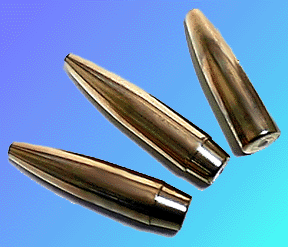
- Hydro-Press (CHP-1)
- Lead hardness virtually unlimited (whatever swages)
- Maximum diameter 1-in soft lead, .720 in hard lead
- Maximum length 3.0 inches
- Maximum jacket wall .125 inches
- Automatic ejection on back stroke
- Floating punch alignment with dies
- Any caliber from .224 to 1-inch within other limits
- Rebated Boattail (RBT) dies available
- Custom shapes and calibers available
- Tubing jacket makers can be used
- Strip drawing .125-thick, 1-inch wide to 2.5 in OAL jacket
- Uses type -H dies only (1.5-inch OD) same as Hydro-press
- Also a powerful reloading press (comes with adapters)
- Can reload .50 BMG with correct shell holder
- Lead Wire Extruder LED-1 option
- Programmable stroke position, length, end points
- Programmable dwell time, stroke cycle
- Auto-feed strip jacket maker option

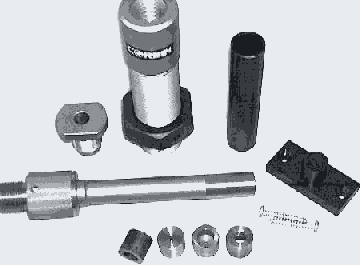 The LED-1 Lead Extruder Die Set is used in the 1-1/2 by 12 threaded top plate of the Corbin Hydro-Press. It cannot be used with any hand-operated press because the pressure required is simply to great. Hydraulic power is required.
The LED-1 Lead Extruder Die Set is used in the 1-1/2 by 12 threaded top plate of the Corbin Hydro-Press. It cannot be used with any hand-operated press because the pressure required is simply to great. Hydraulic power is required.
The kit consists of an extruder die body, which can accept a lead billet of about four inch length by .75 inch diameter, a punch which fits into the press ram using a quick release holder, four die inserts which are used to make any of four standard sizes of lead wire from .185 to .390 inch diameter (if you do not specify the calibers or sizes desired, we normally supply .185, .250, .312 and .365 diameters), and a billet casting set which consists of two four-inch long tubes with honed interior surfaces and a base plug/mount for them. There is also a retaining bushing that screws into the top of the extruder, and holds the die insert against the tremendous extrusion pressures.
The extruder can turn about a pound of lead into wire in one stroke. It is important that the lead be pure, soft lead. Alloys harder than Bhn 5 to 6 will stop the extruder (harder alloys can be extruded using a custom built extruder with a smaller billet diameter. Lubricant must be used on the billet: it reduces the friction so much that it can mean the difference between stalling the ram, and making lead wire flow like a stream of toothpaste flows out of a tube when you step on it!
There are two important warnings about lead extrusion: (1) Never place any part of your body over the top of the extruder, or allow anyone to place their hand or face anywhere near the top of the extruder while it is operating. Under rare circumstances, it may be possible for trapped air to compress in the extruder die and blow out the last piece of lead wire like a shot, which could cause serious injury or death. (2) Always wear leather gloves when handling the extruded wire, as it shoots out quickly and very hot!
The length of lead wire than can be extruded depends on the diameter and length of the billet, compared to the diameter of the final wire produced. You can figure out the length by finding the volume of the original billet (length times cross-sectional area) and then dividing by the cross-sectional area of the final wire product. The cross sectional area is 3.14159 times half the diameter squared, for either the billet or the wire. With a one pound billet, most wire diameters range from several yards for small sizes to several feet for the larger ones. Obviously the pressure goes up as the diameter of wire extruded goes down: you can see that if the diameter extruded was the same as the billet, there would be no pressure (just the weight of the lead billet to lift), and if the extruded wire were infinitely small, there would be infinite pressure required to squeeze it out.
This means that large wire extrudes more easily than small wire: eventually, the press runs out of power to extruder when the wire becomes small enough. To get around this, we can make dies that have more than one hole in them, to reduce the total pressure required. Wires as small as thread, such as .080-inch diameter, can be extruded with a number of holes in the die insert. This fine lead thread can be used for such operations as wrapping fishing lures and making small high pressure gasket seals.
Standard diameters of extruder die inserts kept in stock are: .125, .185, .218, .250, .312, .340, .365, .390. Other sizes can be made to order. Custom shapes can be made, subject to engineering limitations for the strength of the die insert. Four stock dies are included with the extruder at no extra cost.

 The CSU-1 Strip Uncoiler is a device for feeding coiled copper or gilding metal strip to the jacket making die head mounted on the CHP-1 Hydro-press. It handles up to 100 pound coils easily, feeding them from a rotating three-jaw inside chuck that clamps the strip between two huge metal disks to keep the coil aligned horizontally, and holds the coil from the "eye" or inside hole.
The CSU-1 Strip Uncoiler is a device for feeding coiled copper or gilding metal strip to the jacket making die head mounted on the CHP-1 Hydro-press. It handles up to 100 pound coils easily, feeding them from a rotating three-jaw inside chuck that clamps the strip between two huge metal disks to keep the coil aligned horizontally, and holds the coil from the "eye" or inside hole.
A chain-driven motorized assembly inside the steel pedistal receives signals either from the manual control panel on the side of the pedistal, or from a sensor stand that is positioned halfway between the CSU-1 itself and the rear of the CHP-1 press. Usually a distance of six to ten feet is sufficient for the press, sensor, and uncoiler. The strip passes from the top of the coil, between two adjustable sensors that move vertically on a standard, and into the feed fingers of the automatic jacket maker head.
As the jacket maker takes in the strip, inch at a time, and punches and draws it into the first cup, the strip is slowly pulled tighter until it raises to the position of the top sensor. When the top sensor sees the strip, it turns on the uncoiler motor and silently rolls of a partial turn of strip, which drops the strip to the position of the second sensor. The lower or second sensor, upon seeing the strip, turns off the motor. The feed rate and direction can be controlled by a panel on the CSU-1 pedistal. Thus, two units can be set up, one to feed in strip and one to re-coil the punched scrap strip that comes out the other side of the press.
The price of the CSU-1 is considerably less than the price of most industrial strip handlers on the market, but because the CSU-1 is designed specifically for copper or brass strip of 3/4-inch to 1.5 inch width, in the 50 to 100 pound range, it can be built for the most economical price and yet offer features not found on more general purpose handlers.

Hand Cannelure Tool - - - Knurling Tool - - - Grooving Tool
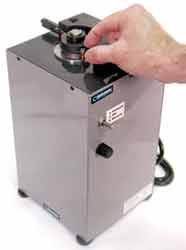 A cannelure - pronounced like "CAN-a-lure" - is a knurled groove impressed in a ring around the bullet. It is used to hold grease lubricant, as a crimping ring for the case neck, for identification, to help the jacket hold the core from shifting forward on impact, and as a guide in seating the bullet to the right depth in the case neck.
A cannelure - pronounced like "CAN-a-lure" - is a knurled groove impressed in a ring around the bullet. It is used to hold grease lubricant, as a crimping ring for the case neck, for identification, to help the jacket hold the core from shifting forward on impact, and as a guide in seating the bullet to the right depth in the case neck.
Cannelures can be rolled into either straight cases, like the .45 or .38 pistol, or into bullets. The purpose of the groove on a pistol case is to act as a shelf to stop the bullet from sliding back into the case during feeding. It would be placed below the bullet, rather than where the bullet shank rests within the case.
 Corbin builds two kinds of tools to make cannelures, the HCT-1 Hand Cannelure Tool, and the PCM-2 Power Cannelure Machine. Both make good cannelures, and are adjustable for position and depth. The PCM-2 can process up to 50 bullets a minute, and the hand tool can handle about four a minute if you are very nimble. The HCT-1 is made for copper or gilding metal jacket bullets in calibers from .224 to .458 only. It is not warrantied for use on steel jackets, solid copper, or calibers outside its range. The HCT-1 has a standard .050-inch wide knurled wheel only.
Corbin builds two kinds of tools to make cannelures, the HCT-1 Hand Cannelure Tool, and the PCM-2 Power Cannelure Machine. Both make good cannelures, and are adjustable for position and depth. The PCM-2 can process up to 50 bullets a minute, and the hand tool can handle about four a minute if you are very nimble. The HCT-1 is made for copper or gilding metal jacket bullets in calibers from .224 to .458 only. It is not warrantied for use on steel jackets, solid copper, or calibers outside its range. The HCT-1 has a standard .050-inch wide knurled wheel only.
The PCM-2 runs on either 115-125 volt 60-Hz power or 220-240 volt 50 Hz power (specify which), has forced air cooling, and is rated for continuous duty. It has an integral 3-amp panel-mounted fuse (Type 3AGC) to protect against overloads. It can be made to handle steel jackets, but is not practical for solid copper or other solid metal bullets. The PCM-2 machine is equipped with the cannelure wheel of your choice for a certain range of diameters, typically all from .224 to .512 can be handled by six wheels. Larger bullets can be handled by addition of special backing plates and wheels.
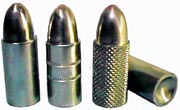 The PCM-2 can also be equipped with knurled back plate and matching knurling wheel, for impressing the surface of lead bullets with a fine diamond pattern that holds far more lubricant than grease grooves, and holds it in a way that does not unbalance the bullet upon exit with grease still attached. Up to 100 times more surface lubricant is held against the bore than with conventional grease grooves, and yet the depth of groove is a fraction as much, which upsets the balance far less and causes far less drag in flight. A hand version called the HCT-2 Knurling Tool is also available. It looks like the HCT-1 but is a different tool. It is only used for lead bullets, not jacketed.
The PCM-2 can also be equipped with knurled back plate and matching knurling wheel, for impressing the surface of lead bullets with a fine diamond pattern that holds far more lubricant than grease grooves, and holds it in a way that does not unbalance the bullet upon exit with grease still attached. Up to 100 times more surface lubricant is held against the bore than with conventional grease grooves, and yet the depth of groove is a fraction as much, which upsets the balance far less and causes far less drag in flight. A hand version called the HCT-2 Knurling Tool is also available. It looks like the HCT-1 but is a different tool. It is only used for lead bullets, not jacketed.
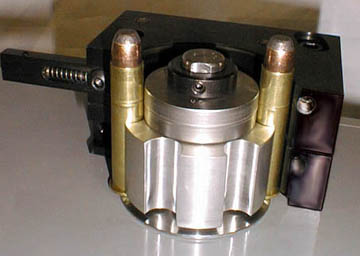
 The PCM-2 can also be provided with an optional bullet feed "carousel" device to aid in reliable feeding of tall or boattail shaped bullets (which want to fall over when stood on their base). This feeder can be used in conjunction with a custom back plate and grooving wheel to put accurate cannelures on cartridges, such as the .45 ACP, 9mm, or .45-70. Up to 100 cartridges per minute can have the cannelure applied, normally just below the position of the bullet base, which prevents the bullet from shoving back into the case during feeding.
The PCM-2 can also be provided with an optional bullet feed "carousel" device to aid in reliable feeding of tall or boattail shaped bullets (which want to fall over when stood on their base). This feeder can be used in conjunction with a custom back plate and grooving wheel to put accurate cannelures on cartridges, such as the .45 ACP, 9mm, or .45-70. Up to 100 cartridges per minute can have the cannelure applied, normally just below the position of the bullet base, which prevents the bullet from shoving back into the case during feeding.
|



